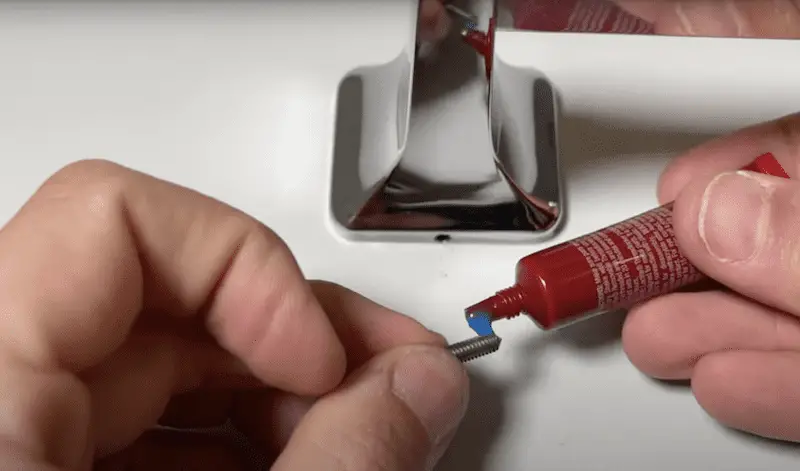What exactly is Loctite / threadlocker and where would you use it around your home? How can it help you with your repairs and maintenance?
Recently, I did a survey and found that about 40 percent of people either haven’t heard of Loctite / threadlocker or haven’t used it around the house. Since I use it repeatedly, I wanted to introduce you to the purposes of Loctite (or what I like to call… Magic Blue Liquid!), and show you how it can help you save money and time on your own house and any rental properties you may have.
In this blog, we’ll cover a brief background on Loctite and how to decide between blue and red. Plus, I’ll walk you through three practical uses for Loctite on bathroom hardware, doorknobs, and cabinet hardware.
DISCLAIMER: This blog contains affiliate links, which means that if you click on one of the product links, I’ll receive a small commission.
What is Loctite / Threadlocker?
First off, Loctite is the brand name that came up with an anaerobic adhesive back in the 1950s that was called “threadlocker.” Nowadays multiple different brands make threadlocker but because Loctite was the original – and still the most well known – it’s kind of synonymous with each other. (Think: Kleenex for tissue, Post Its for sticky notes, and Tupperware for food storage.) So I often refer to it as Loctite even though I actually mean threadlocker.
Overall, the goal of Loctite is to prevent fasteners (like screws and bolts) from loosening. By applying a little dot of the adhesive, you’ll help them stay secure. While can be used in all sorts of different applications (cars, yard equipment etc.), for the purposes of this blog, we’ll focus on its practical purposes in the home.
Loctite: Red vs. Blue
Loctite comes in multiple different types. The most common are blue and red. If you don’t want to dive too deep just think of red as permanent and more for an industrial or demanding application where you want it to be permanent.
I do not use much red around the house. I use blue which is a removable threadlocker and more applicable for maintenance projects around the house.
3 Super Practical Uses for Loctite / Threadlocker
1. Bathroom Hardware (Toilet Paper Holders, Towel Racks, Etc)

Do your towel racks and toilet paper holders often come loose? I know the feeling! Any hardware with a small set screw that’s either loosened or tightened by a flat head screwdriver (or Allen wrench) is a great use for Loctite. As you probably know, these little screws notoriously come loose over time as people push, pull, and hang things on them. Eventually, they often fall off the bracket that’s on the wall, which can be a pain to put back together.
How to use Loctite: With one small drop of blue (as seen above), you can tighten the screws more securely. It’ll help prevent your bathroom hardware from falling off.
2. Doorknobs and Door Handles

Threadlocker is also helpful to keep doorknobs or door handles secured. I find it most useful on my exterior doors as opposed to interiors. This might be because they’re getting more use and force, as they are opened and closed over time.
In fact, before I started using threadlocker, I had two calls from tenants that allowed the doorknob to get so loose – it fell off before they called me. So it’s nice to use Loctite to avoid this!
How to use Loctite: I like to put one small drop of blue on the two screws on the doorknob. Then for good measure, I even put a little on the deadbolt. (Dealing with a misaligned deadbolt? Check out this post.)
3. Cabinet Hardware

Lastly, I use threadlocker for cabinet hardware. Depending on the type of cabinet hardware you have – handles or knobs – you may deal with it loosening up over time even if you continue to tighten them up. I know how irritating that can be! So one small drop of blue is going to really help hold the screw in.
How to use Loctite: On cabinet hardware, I place the drop on the threaded knob or handle side as opposed to the screw side. When I pass the screw through the wood of the door, I don’t wipe off the Loctite. Instead, it stays on the threads. This gives it a better bond because you’re not getting sawdust or debris in as you’re pushing the screw through the door.
The Wrap Up
I hope those three examples show you the practical purposes of Loctite. Ultimately, I find it not only reduces the maintenance calls that I get from people staying at my rental properties, but it also reduces the things I need to do between tenants. It’s also easy to apply, so it’s not a pain to take the extra preventative step. And if you have other uses for threadlocker, let me know in the comments!
Do you use plumber’s putty? Read out my honest review on plumber’s putty and insight about the dring time.



